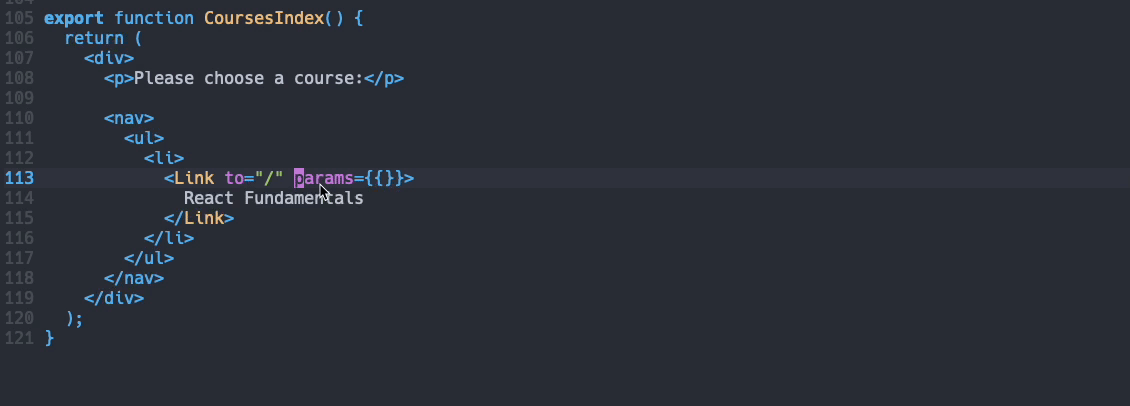Typed route paths & typed route parameters on top of React Router V6, providing better editor support and increased safety.
- Out of the box
- Automatically infer route params
- Better editor support
- Increased type safety
typed-react-router uses a combination of typescipt's conditional types & template literal types to infer the route patterns of your app on compile time.
The main aim of typed-react-router is to be:
- Type-safe
- Explicit
- Refactorable
- React Router V6 compatible
It discourages links to relative paths and allows the editor to provide auto-completion of absolute paths. This has the advantages of:
- You directly see where a link will be navigating to
- You get auto-completions on all route patterns
- Modifying the (parent) routes will result in compile errors
- Correct route parameters are enforced by the type system
During route declaration, you may use both absolute & relative route paths. When you want to navigate to a route, absolute paths need to be used.
npm install typed-react-router
yarn add typed-react-router
typed-react-router works with any project that uses React Router V6 and is built upon its route objects api
- You need to define your routes as Route Objects
- Make a
constassertion of your routes so that no literal types will be widened (e.g. no going from"/courses"tostring). This will enable the typescript compiler to infer the route patterns
export const routes = [
{
path: '/',
element: <Layout />,
children: [
{ index: true, element: <Home /> },
{
path: 'courses',
element: <Courses />,
children: [
{ index: true, element: <CoursesIndex /> },
{
path: 'details/:courseId',
element: <Course />,
children: [
{
path: 'students',
element: <Students />,
children: [
{ index: true, element: <StudentsIndex /> },
{ path: ':studentId', element: <Student /> },
],
},
],
},
],
},
{ path: '*', element: <NoMatch /> },
],
},
] as const // <-- Make sure to use 'as const' instead of a type name- Construct a typed router
export const TypedRouter = constructTypedRouter(routes)- Use the routes and make sure that the router context is available
For example:
<BrowserRouter>
<App />
</BrowserRouter>export function Layout() {
return (
<div>
<nav>
<ul>
<li>
<TypedRouter.Link to="/">Home</TypedRouter.Link>
</li>
<li>
<TypedRouter.Link to="/courses">Courses</TypedRouter.Link>
</li>
<li>
<TypedRouter.Link
to="/courses/details/:courseId"
params={{ courseId: 'nothing' }}
>
Nothing Here
</TypedRouter.Link>
</li>
</ul>
</nav>
<hr />
<Outlet />
</div>
)
}This library supports both relative and absolute paths in your routes declarations (the ones that you pass to useRoutes, same as in react-router.
Like explained in the Principles section above, typed-react-router is meant to be used by pointing to absolute route paths.
This means that the following code (taken from the Route objects react-router example):
const routes: RouteObject[] = [
{
path: "/",
element: <Layout />,
children: [
{ index: true, element: <Home /> },
{
path: "/courses",
element: <Courses />,
children: [
{ index: true, element: <CoursesIndex /> },
{ path: "/courses/details/:courseId", element: <Course /> }
]
},
{ path: "*", element: <NoMatch /> }
]
}
];
...
// omitted for brevity
...
function CoursesIndex() {
return (
<div>
<p>Please choose a course:</p>
<nav>
<ul>
<li>
<Link to="react-fundamentals">
React Fundamentals
</Link>
</li>
<li>
<Link to="advanced-react">
Advanced React
</Link>
</li>
<li>
<Link to="react-router">
React Router
</Link>
</li>
</ul>
</nav>
</div>
);
}will become:
const { Link } from TypedRouter;
export function CoursesIndex() {
return (
<div>
<p>Please choose a course:</p>
<nav>
<ul>
<li>
<Link
to="/courses/details/:courseId"
params={{ courseId: "react-fundamentals" }}
>
React Fundamentals
</Link>
</li>
<li>
<Link
to="/courses/details/:courseId"
params={{ courseId: "advanced-react" }}
>
Advanced React
</Link>
</li>
<li>
<Link
to="/courses/details/:courseId"
params={{ courseId: "react-router" }}
>
React Router
</Link>
</li>
</ul>
</nav>
</div>
);
}You can always still use react-router directly as you might seem fit.
